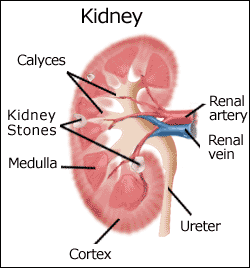Kidney Stones

Gilbert sms-ed me this morning that he will be going for the minor operation to remove the kidney stones. He complained of the pain at his lower back since Sunday and we thought that the pain would go away if he drank plenty of water to flush the stone out of the kidney. However, according to the CT scan, the 3.5mm stone was found to be lodged in his kidney and he has to go for the operation to have few stones surgically removed.
So, tonight I will be seeing him and I really hope that he will be released from constant pain that kept on plaguing him. Sigh..he has gone through a lot in life and he once told me that he had a near-death experience where the black guys mugged him and knocked on his head using the metal club. And he told me how he managed to fight back to be alive from the razor-thin between life and death.
What is a kidney stone?
A kidney stone is a hard mass developed from crystals that separate from the urine and build up on the inner surfaces of the kidney. Normally, urine contains chemicals that prevent or inhibit the crystals from forming. These inhibitors do not seem to work for everyone, however, so some people form stones. If the crystals remain tiny enough, they will travel through the urinary tract and pass out of the body in the urine without being noticed.
Kidney stones may contain various combinations of chemicals. The most common type of stone contains calcium in combination with either oxalate or phosphate. These chemicals are part of a person's normal diet and make up important parts of the body, such as bones and muscles.
A less common type of stone is caused by infection in the urinary tract. This type of stone is called a struvite or infection stone. A bit less common is the uric acid stone. Cystine stones are rare.
Who gets kidney stones?
For unknown reasons, the number of people in the United States with kidney stones has been increasing over the past 30 years. The prevalence of stone-forming disease rose from 3.8 percent in the late 1970s to 5.2 percent in the late 1980s and early 1990s. White Americans are more prone to develop kidney stones than African Americans. Stones occur more frequently in men. The prevalence of kidney stones rises dramatically as men enter their 40s and continues to rise into their 70s. For women, the prevalence of kidney stones peaks in their 50s. Once a person gets more than one stone, others are likely to develop.
What are the symptoms?
Kidney stones often do not cause any symptoms. Usually, the first symptom of a kidney stone is extreme pain, which occurs when a stone acutely blocks the flow of urine. The pain often begins suddenly when a stone moves in the urinary tract, causing irritation or blockage. Typically, a person feels a sharp, cramping pain in the back and side in the area of the kidney or in the lower abdomen. Sometimes nausea and vomiting occur. Later, pain may spread to the groin.
If the stone is too large to pass easily, pain continues as the muscles in the wall of the tiny ureter try to squeeze the stone along into the bladder. As a stone grows or moves, blood may appear in the urine. As the stone moves down the ureter closer to the bladder, you may feel the need to urinate more often or feel a burning sensation during urination.
If fever and chills accompany any of these symptoms, an infection may be present. In this case, you should contact a doctor immediately.
How are kidney stones treated?
Fortunately, surgery is not usually necessary. Most kidney stones can pass through the urinary system with plenty of water (2 to 3 quarts a day) to help move the stone along. Often, you can stay home during this process, drinking fluids and taking pain medication as needed. The doctor usually asks you to save the passed stone(s) for testing. (You can catch it in a cup or tea strainer used only for this purpose.)
The First Step: Prevention
If you've had more than one kidney stone, you are likely to form another; so prevention is very important. To prevent stones from forming, your doctor must determine their cause. He or she will order laboratory tests, including urine and blood tests. Your doctor will also ask about your medical history, occupation, and eating habits. If a stone has been removed, or if you've passed a stone and saved it, the laboratory should analyze it because its composition helps in planning treatment.
You may be asked to collect your urine for 24 hours after a stone has passed or been removed. The sample is used to measure urine volume and levels of acidity, calcium, sodium, uric acid, oxalate, citrate, and creatinine (a product of muscle metabolism). Your doctor will use this information to determine the cause of the stone. A second 24-hour urine collection may be needed to determine whether the prescribed treatment is working.
Lifestyle Changes
A simple and most important lifestyle change to prevent stones is to drink more liquids—water is best. If you tend to form stones, you should try to drink enough liquids throughout the day to produce at least 2 quarts of urine in every 24-hour period.
People who form calcium stones used to be told to avoid dairy products and other foods with high calcium content. But recent studies have shown that foods high in calcium, including dairy products, may help prevent calcium stones. Taking calcium in pill form, however, may increase the risk of developing stones.
You may be told to avoid food with added vitamin D and certain types of antacids that have a calcium base. If you have very acidic urine, you may need to eat less meat, fish, and poultry. These foods increase the amount of acid in the urine.
To prevent cystine stones, you should drink enough water each day to dilute the concentration of cystine that escapes into the urine, which may be difficult. More than a gallon of water may be needed every 24 hours, and a third of that must be drunk during the night.
Foods and Drinks Containing Oxalate
People prone to forming calcium oxalate stones may be asked by their doctor to cut back on certain foods if their urine contains an excess of oxalate:
- beets
- chocolate
- coffee
- cola
- nuts
- rhubarb
- spinach
- strawberries
- tea
- wheat bran
People should not give up or avoid eating these foods without talking to their doctor first. In most cases, these foods can be eaten in limited amounts.
Medical Therapy
The doctor may prescribe certain medications to prevent calcium and uric acid stones. These drugs control the amount of acid or alkali in the urine, key factors in crystal formation. The drug allopurinol may also be useful in some cases of hyperuricosuria.
Doctors usually try to control hypercalciuria, and thus prevent calcium stones, by prescribing certain diuretics, such as hydrochlorothiazide. These drugs decrease the amount of calcium released by the kidneys into the urine by favoring calcium retention in bone. They work best when sodium intake is low.
Very rarely, patients with hypercalciuria may be given the drug sodium cellulose phosphate, which binds calcium in the intestines and prevents it from leaking into the urine.
If cystine stones cannot be controlled by drinking more fluids, your doctor may prescribe drugs such as Thiola and Cuprimine, which help reduce the amount of cystine in the urine.
For struvite stones that have been totally removed, the first line of prevention is to keep the urine free of bacteria that can cause infection. Your urine will be tested regularly to be sure that no bacteria are present.
If struvite stones cannot be removed, your doctor may prescribe a drug called acetohydroxamic acid (AHA). AHA is used with long-term antibiotic drugs to prevent the infection that leads to stone growth.
People with hyperparathyroidism sometimes develop calcium stones. Treatment in these cases is usually surgery to remove the parathyroid glands (located in the neck). In most cases, only one of the glands is enlarged. Removing the glands cures the patient's problem with hyperparathyroidism and with kidney stones as well.
Prevention Points to Remember
If you have a family history of stones or have had more than one stone, you are likely to develop more stones.
A good first step to prevent the formation of any type of stone is to drink plenty of liquids—water is best.
If you are at risk for developing stones, your doctor may perform certain blood and urine tests to determine which factors can best be altered to reduce that risk.
Some people will need medicines to prevent stones from forming.
People with chronic urinary tract infections and stones will often need the stone removed if the doctor determines that the infection results from the stone's presence. Patients must receive careful followup to be sure that the infection has cleared.


5 Comments:
Hee, thank you for a very detailed accounting of my kidney stone experience. I am so thankful to have had the excellent medical care at Gleneagles and Mt Elizabeth, and most of all for my wonderful family who rushed over to see me at the hospital and to friends like you who took so much care and time to come and spend time with me.
Hug hug
-Gil
Greets to the webmaster of this wonderful site! Keep up the good work. Thanks.
»
Interesting website with a lot of resources and detailed explanations.
»
I really enjoyed looking at your site, I found it very helpful indeed, keep up the good work.
»
Interesting website with a lot of resources and detailed explanations.
»
Post a Comment
<< Home